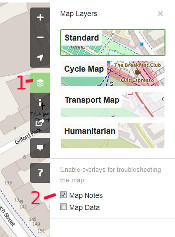Notes
Notes is a core feature of the OpenStreetMap.org website. It enables you to add a comment on the map to assist others in mapping/editing OpenStreetMap. Other users can respond to your notes, for example to ask for additional details if necessary.
Please do not use notes for general discussion or storing information not otherwise used in OpenStreetMap. For example never create notes such as "I was here on Saturday" or "There was a crime at this location".
Although it is not necessary to be logged in to submit a new note, it is beneficial to do so. Logged-in users will receive an email if comments are added to a note or the issue is resolved.
Using notes
| |
| |
The notes feature of OpenStreetMap allows both registered users and the wider public to quickly indicate where there are errors or omissions in the OpenStreetMap data, and for contributors to OpenStreetMap to know where their support is needed.
Adding notes
To add a note, click the bottom tool bar button on the right side of the main OSM map.
Move the marker to the correct position (as accurately as you can). Leave a short text message for contributors to Openstreetmap to tell them what's wrong or missing.
Be clear in your message, for example consider that "path wrong" says very little of use, but "The east-west path on map does not exist on the ground" is very clear.
If you have an OpenStreetMap account, you should login first to have your note associated with your username, but casual visitors can easily add a note too. If you want to be more than a casual visitor, create an account.
Entered text is treated as a plain text, though for example openstreetmap.org will recognize and autoformat links. Formatting with markdown is not supported - unlike private messages and diary entries.
Viewing notes
To view all the current notes for an area go to the openstreetmap.org main map display, click the 'layer picker' control on the top right of the map, and select the 'Notes' checkbox (see image).
The note markers have the varying styles shown in the image below:
| Icon | Description |
|---|---|
| New note location (while being added) | |
| Unresolved note location | |
| Resolved note location (older such notes will not be shown) |
After selecting a note, you can comment on it, for example, to ask the contributor questions (if they were logged in when adding the note) or to add additional information.
Resolving notes
Notes that are no longer valid should be marked as resolved (requires log in). For example, a note that relates to a map error should be marked resolved once the map has been updated to fix the error. Duplicate or invalid notes should also be marked as resolved.
Resolved notes are not removed or deleted. After a period of seven days they are hidden from view. Hidden notes can be viewed using the RSS feed and the closed=-1 parameter like that:
http://api.openstreetmap.org/api/0.6/notes/feed?bbox=smaller_longitude,smaller_latitude,larger_longitude,larger_latitude&closed=-1
See this question on the OSM Help forum for more details about how to view hidden notes.
Reporting notes
It is also possible to report notes using the »Report this note« link below the first comment (requires log in). This should be done in the case of spam, notes containing abusive or illegal content, or where sensitive or confidential information appears in notes. The data working group will review all reported notes and permanently hide the inappropriate ones.
Support in editors
OSM editors offer various support for notes.
iD and JOSM can show and act on them but it requires using special option.
Vespucci downloads and shows notes by default, together with Osmose errors.
StreetComplete shows notes that include questions and can be configured to show all of them. StreetComplete users can also manually leave notes, especially when objects for given quest is outdated (for example user is asked about opening hours of shop that is gone). StreetComplete has special support for easy way of making photos and including them in a note as links.
Further reading
- Notes/Common errors - Common data entry errors.
- Notes/Advanced use - More advanced usage of notes (for example statistics, filtering by area and data export).
- Notes/Applications using notes - A list of third party applications using notes.
- Notes/API and development - The notes API and code.
See also
The following two tag keys:
- key:note – only a similar name, quite different function (used to inform other mappers about non-obvious information about an element)
- key:fixme – partly a similar function (allows contributors to mark objects and places that need further attention)
External links
- OSM notes statistics, with links to per-country statistics
- Notes Review
- Top users by number of created/closed notes (switch to notes tab)
| ||||||||||||||||||||||||||



